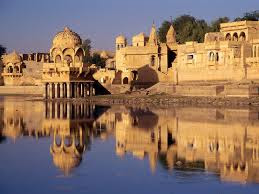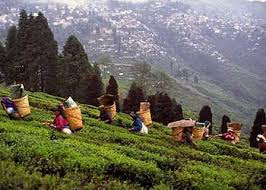Jaisalmer
Jaisalmer also known as "The Golden city", is a city in the Indian state of Rajasthan. The town stands on a ridge of yellowish sandstone, crowned by a fort, which contains the palace and several ornate Jain temples. Many of the houses and temples are finely sculptured. The yellow sand and the yellow sandstone used in every architecture of the city gives a yellowish-golden tinge to the city and its surrounding area.
In the 13th century, Jaisalmer escaped direct Turkic conquest due to its geographical situation in the desert region. The Rawals of Jaisalmer agreed to pay an annual tribute to the Turkic Sultans of Delhi. Sultan Ferozshah also besieged Jaisalmer after the rulers of Jaisalmer raided his camp at Anasagar lake near Ajmer.
On the eve of British Raj in India, Jaisalmer was subservient to the Marathas, until it came under the protection of the British East India Company following the British victory in the Third Anglo-Maratha War. In 1818, the Rawals of Jaisalmer signed a treaty with the British, which protected Jaisalmer from invasion provided it was not the aggressor and guaranteed the royal succession.
The Rajasthan Canal served to revive the surrounding desert areas. Roads and railroads were then built, knitting the hitherto remote town with the rest of Rajasthan. Tourism is a major industry in Jaisalmer. The Government of India initiated departmental exploration for oil in 1955–56 in the Jaisalmer area. Oil India Limited discovered natural gas in 1988 in the Jaisalmer basin.
Musicians and dancers are also a major cultural export from Jaisalmer to the rest of the world. Jaisalmer is major and one of the most preferred event organizing destination in Rajasthan.
While Jaisalmer may always have been remote, it is filled with many artistic structures and monuments of local historical importance. Jaisalmer's medieval mud fortress and walled township make it a popular tourist destination. The surrounding desolate landscape evidences a stark, austere beauty. Camel safaris through the nearby desert dunes are popular with tourists; competition for business is fierce.
Darjeeling
Jaisalmer also known as "The Golden city", is a city in the Indian state of Rajasthan. The town stands on a ridge of yellowish sandstone, crowned by a fort, which contains the palace and several ornate Jain temples. Many of the houses and temples are finely sculptured. The yellow sand and the yellow sandstone used in every architecture of the city gives a yellowish-golden tinge to the city and its surrounding area.
In the 13th century, Jaisalmer escaped direct Turkic conquest due to its geographical situation in the desert region. The Rawals of Jaisalmer agreed to pay an annual tribute to the Turkic Sultans of Delhi. Sultan Ferozshah also besieged Jaisalmer after the rulers of Jaisalmer raided his camp at Anasagar lake near Ajmer.
On the eve of British Raj in India, Jaisalmer was subservient to the Marathas, until it came under the protection of the British East India Company following the British victory in the Third Anglo-Maratha War. In 1818, the Rawals of Jaisalmer signed a treaty with the British, which protected Jaisalmer from invasion provided it was not the aggressor and guaranteed the royal succession.
The Rajasthan Canal served to revive the surrounding desert areas. Roads and railroads were then built, knitting the hitherto remote town with the rest of Rajasthan. Tourism is a major industry in Jaisalmer. The Government of India initiated departmental exploration for oil in 1955–56 in the Jaisalmer area. Oil India Limited discovered natural gas in 1988 in the Jaisalmer basin.
Musicians and dancers are also a major cultural export from Jaisalmer to the rest of the world. Jaisalmer is major and one of the most preferred event organizing destination in Rajasthan.
While Jaisalmer may always have been remote, it is filled with many artistic structures and monuments of local historical importance. Jaisalmer's medieval mud fortress and walled township make it a popular tourist destination. The surrounding desolate landscape evidences a stark, austere beauty. Camel safaris through the nearby desert dunes are popular with tourists; competition for business is fierce.
Darjeeling
Darjeeling is a town and a municipality in the Indian state of West Bengal. It is very well known all over the world for its tea industry and the Darjeeling Himalayan Railway, a UNESCO World Heritage Site. Darjeeling is the headquarters of Darjeeling district which has a partially autonomous status within the state of West Bengal.
The Darjeeling Himalayan Railway connects the town with the plains and has one of the few steam locomotives still in service in India.
Darjeeling has several British-style public schools, which attract students from India and neighboring countries. The town's fragile ecology has been threatened by a rising demand for environmental resources, stemming from growing tourist traffic and poorly planned urbanization.
The history of Darjeeling is intertwined with that of Sikkim, Nepal, British India and Bhutan. During the British Raj, Darjeeling's temperate climate led to its development as a hill station for British residents seeking to escape the summer heat of the plains. The development of Darjeeling as a sanatorium and health resort proceeded briskly. Arthur Campbell, a surgeon with the Company, and Lieutenant Robert Napier were responsible for establishing a hill station there.
Darjeeling is a part of the Eastern Himalayan zoo-geographic zone. Flora around Darjeeling comprises sal, oak, semi-evergreen, temperate and alpine forests. Wildlife in the district is protected by the wildlife wing of the West Bengal Forest Department. Animals found here include the one-horned rhinoceros, elephant, tiger, leopard and hog deer, while the main bird species include the Bengal florican and herons.
Natural springs in the Senchal Range provide most of Darjeeling's water supply. The two most significant contributors to Darjeeling's economy are tourism and the tea industry. Darjeeling tea, due to the unique agro-climatic conditions of Darjeeling, has a distinctive natural flavour, is internationally reputed and recognised as a geographical indicator.
Darjeeling had become an important tourist destination as early as 1860. It is also a popular filming destination for Bollywood and Bengali cinema. Apart from the major religious festivals of Dashain (Durga puja), Tihar (Diwali) and Christmas the diverse ethnic populace of the town celebrates several local festivals. The Lepchas and Bhutias celebrate new year in January, while Tibetans celebrate their new year, Losar, in February–March.
The Darjeeling Himalayan Railway connects the town with the plains and has one of the few steam locomotives still in service in India.
Darjeeling has several British-style public schools, which attract students from India and neighboring countries. The town's fragile ecology has been threatened by a rising demand for environmental resources, stemming from growing tourist traffic and poorly planned urbanization.
The history of Darjeeling is intertwined with that of Sikkim, Nepal, British India and Bhutan. During the British Raj, Darjeeling's temperate climate led to its development as a hill station for British residents seeking to escape the summer heat of the plains. The development of Darjeeling as a sanatorium and health resort proceeded briskly. Arthur Campbell, a surgeon with the Company, and Lieutenant Robert Napier were responsible for establishing a hill station there.
Darjeeling is a part of the Eastern Himalayan zoo-geographic zone. Flora around Darjeeling comprises sal, oak, semi-evergreen, temperate and alpine forests. Wildlife in the district is protected by the wildlife wing of the West Bengal Forest Department. Animals found here include the one-horned rhinoceros, elephant, tiger, leopard and hog deer, while the main bird species include the Bengal florican and herons.
Natural springs in the Senchal Range provide most of Darjeeling's water supply. The two most significant contributors to Darjeeling's economy are tourism and the tea industry. Darjeeling tea, due to the unique agro-climatic conditions of Darjeeling, has a distinctive natural flavour, is internationally reputed and recognised as a geographical indicator.
Darjeeling had become an important tourist destination as early as 1860. It is also a popular filming destination for Bollywood and Bengali cinema. Apart from the major religious festivals of Dashain (Durga puja), Tihar (Diwali) and Christmas the diverse ethnic populace of the town celebrates several local festivals. The Lepchas and Bhutias celebrate new year in January, while Tibetans celebrate their new year, Losar, in February–March.
GOA
Panaji
Arambol Beach,
Palolem Beach,
Anjuna Beach.
Gulmarg
Shalimar Garden
Sonamarg
Dal Lake
Kerala- KOCHI
Kochi (formerly known as Cochin) with its beautiful lagoons, lakes and greenery, is called the Queen of the Arabian Sea and perfectly reflects the eclecticism of the state of Kerala.
MUMBAI
Mumbai - or Bombay as it was formerly known, remains India’s city of dreams. Built largely by the British around one of the best-protected natural harbours in the world, Mumbai is India’s strategic economic centre. The city is also is home to the country’s prolific Bollywood film industry, which produces more feature films than any place in the world.
Himachal Pradesh- SHIMLA, MANALI, DHARAMSHALA
The largest and most famous of the British hill stations, Shimla is the capital of the state of Himachal Pradesh
Radhanagar Beach
Havelock Island
Cellular Beach
Barren Island
Kaziranga National Park
Majuli
Kamakhya Temple
Agnigarh Hill
Nalanda
Vikramshila
Bodh Gaya
Saputara Hills
Keshava Temple
Mysore Palace
Gol Gumbaz
Munnar
Kumarakom
















No comments:
Post a Comment